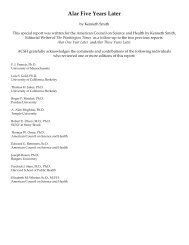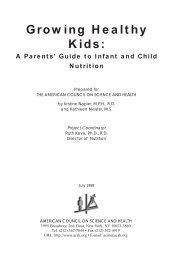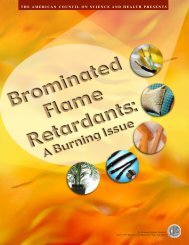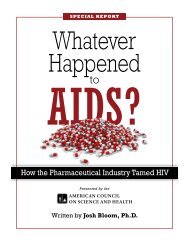The Role of Beef in the American Diet - International Meat Secretariat
The Role of Beef in the American Diet - International Meat Secretariat
The Role of Beef in the American Diet - International Meat Secretariat
You also want an ePaper? Increase the reach of your titles
YUMPU automatically turns print PDFs into web optimized ePapers that Google loves.
<strong>The</strong> <strong>Role</strong> <strong>of</strong> <strong>Beef</strong> <strong>in</strong> <strong>the</strong> <strong>American</strong> <strong>Diet</strong><br />
experts disagree about its relative importance and about <strong>the</strong> changes that<br />
may need to be made <strong>in</strong> antibiotic use practices (45, 48–50). One reason<br />
why views differ is that gaps exist <strong>in</strong> <strong>the</strong> available data on how antibiotics<br />
are be<strong>in</strong>g used and on <strong>the</strong> connections between patterns <strong>of</strong> antibiotic<br />
use and <strong>the</strong> development <strong>of</strong> antibiotic resistance. Better monitor<strong>in</strong>g<br />
and more research are needed. All experts agree, however, that antibiotics<br />
should be used judiciously, and only when truly necessary.<br />
<strong>The</strong> Food and Drug Adm<strong>in</strong>istration, which regulates <strong>the</strong> use <strong>of</strong> animal<br />
drugs, is chang<strong>in</strong>g <strong>the</strong> way <strong>in</strong> which it regulates antibiotics used <strong>in</strong><br />
livestock to place more emphasis on <strong>the</strong> problem <strong>of</strong> antibiotic resistance<br />
(51). <strong>The</strong> new policies are likely to lead to <strong>the</strong> discont<strong>in</strong>uation <strong>of</strong> use <strong>in</strong><br />
animals <strong>of</strong> certa<strong>in</strong> antibiotics <strong>of</strong> special importance <strong>in</strong> human medic<strong>in</strong>e<br />
(this has already happened with one antibiotic formerly used <strong>in</strong> poultry<br />
production). In addition, FDA now requires that effects on antibiotic<br />
resistance must be assessed when new antibiotics <strong>in</strong>tended for use <strong>in</strong><br />
food animals are evaluated (52).<br />
MICROBIOLOGICAL FOOD SAFETY ISSUES<br />
Contrary to popular belief, chemicals <strong>in</strong> food are not <strong>the</strong> major<br />
cause <strong>of</strong> foodborne illnesses. <strong>The</strong> real danger is disease-caus<strong>in</strong>g<br />
microorganisms. Some experts estimate that foodborne diseases caused<br />
by microorganisms account for roughly 76 million illnesses, 325,000<br />
hospitalizations, and 5,000 deaths <strong>in</strong> <strong>the</strong> U.S. each year (53).<br />
<strong>The</strong> follow<strong>in</strong>g sections <strong>of</strong> this report discuss food safety issues as<br />
<strong>the</strong>y perta<strong>in</strong> to beef. First, <strong>the</strong> specific types <strong>of</strong> disease-caus<strong>in</strong>g microorganisms<br />
that may be found <strong>in</strong> beef will be discussed. <strong>The</strong>n, <strong>in</strong>formation<br />
on <strong>the</strong> safe handl<strong>in</strong>g <strong>of</strong> beef and o<strong>the</strong>r foods will be presented. F<strong>in</strong>ally,<br />
<strong>the</strong> technology <strong>of</strong> irradiation — which has much to <strong>of</strong>fer <strong>in</strong> terms <strong>of</strong><br />
improv<strong>in</strong>g <strong>the</strong> microbiological safety <strong>of</strong> many foods, <strong>in</strong>clud<strong>in</strong>g beef —<br />
will be briefly summarized.<br />
VII. Specific Disease-Caus<strong>in</strong>g Microorganisms<br />
Different types <strong>of</strong> food are at risk <strong>of</strong> contam<strong>in</strong>ation with different<br />
microorganisms. In <strong>the</strong> case <strong>of</strong> beef, three organisms <strong>of</strong> special concern<br />
are E. coli O157:H7, Salmonella, and Listeria monocytogenes.<br />
E. coli O157:H7<br />
Escherichia coli, more commonly known as E. coli, is a type <strong>of</strong><br />
bacterium commonly found <strong>in</strong> <strong>the</strong> <strong>in</strong>test<strong>in</strong>es <strong>of</strong> warm-blooded animals,<br />
<strong>in</strong>clud<strong>in</strong>g livestock and humans. Most stra<strong>in</strong>s <strong>of</strong> this bacterium are<br />
harmless, but a few can cause illness.<br />
23










